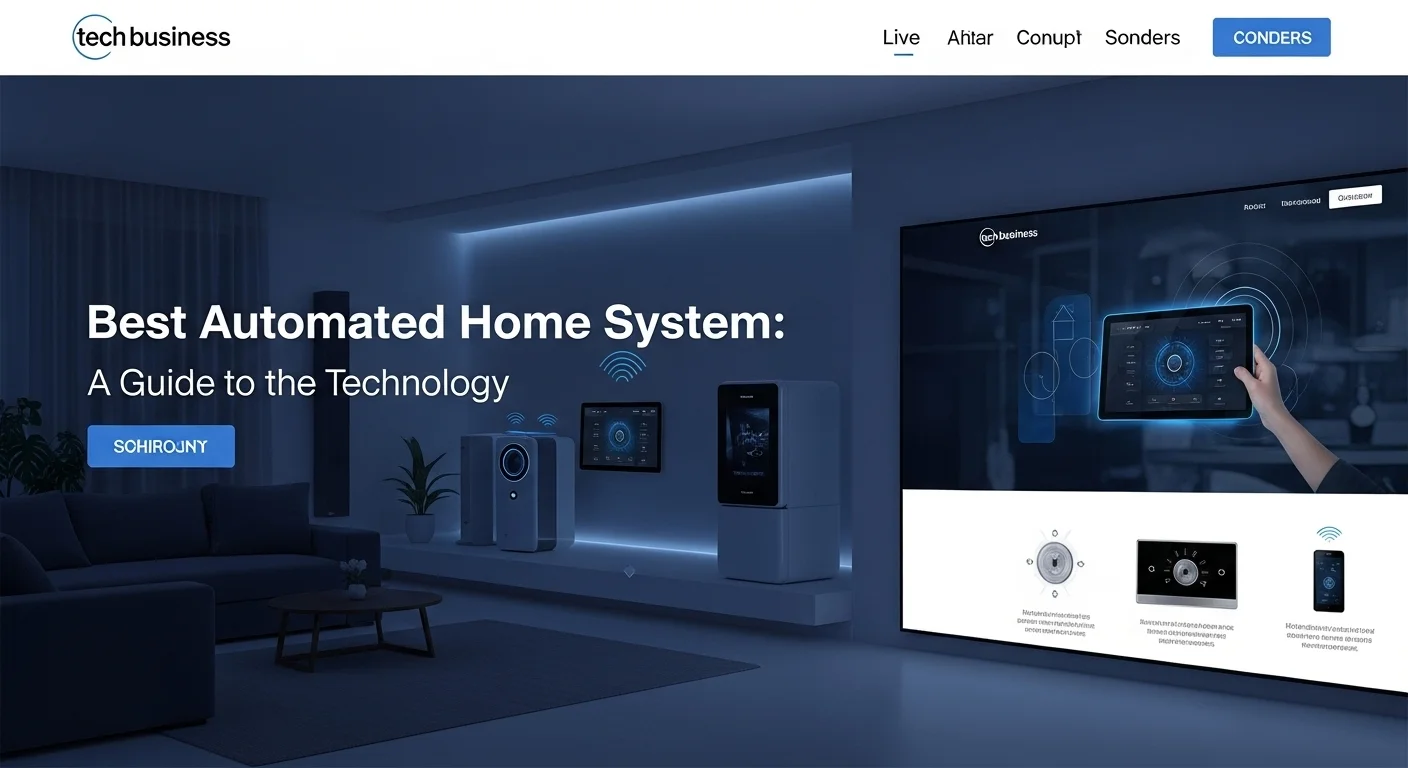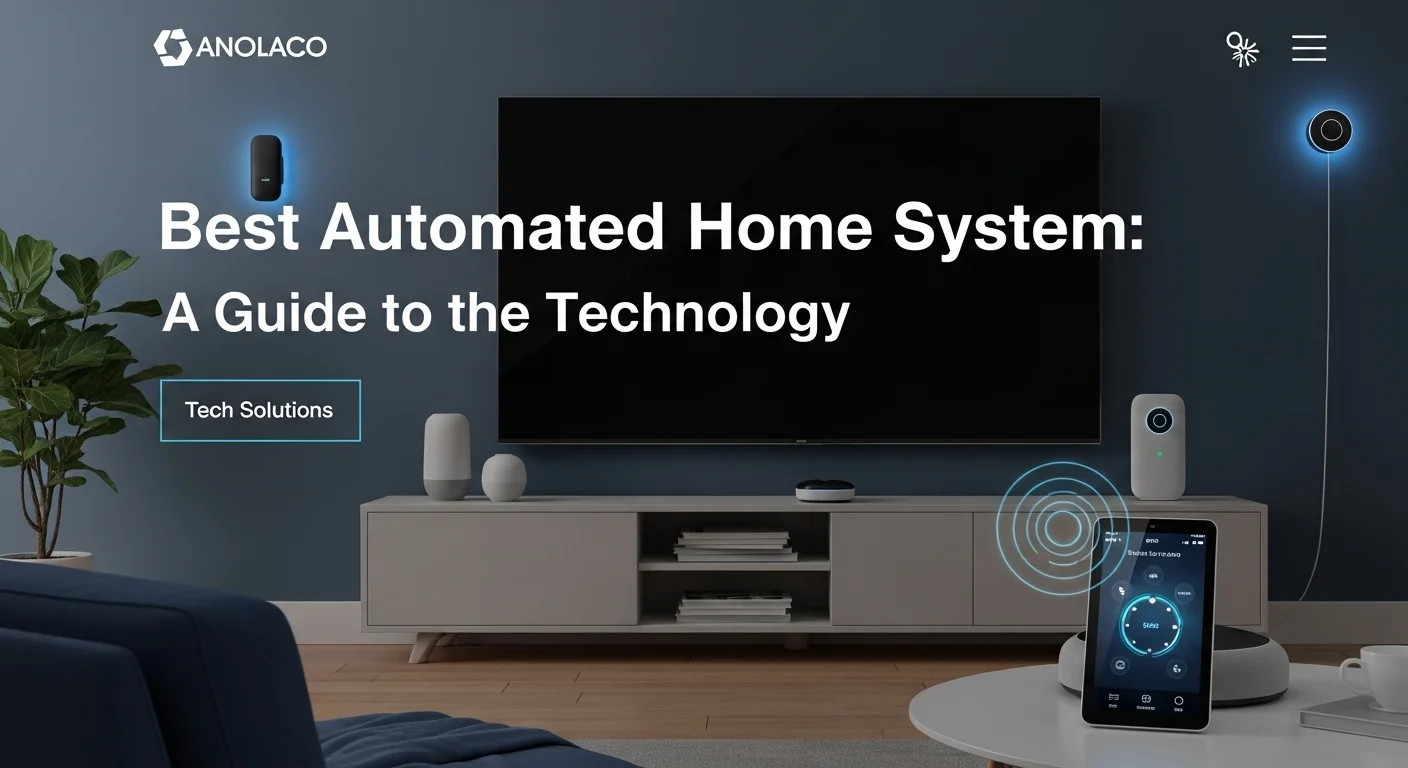Smart Home Simplified: Your Guide to the Best Automation System in 2025

Executive Summary
I've spent over a decade in the trenches of home technology, connecting everything from simple smart plugs to complex, whole-house automation systems. I've seen the industry evolve from a niche hobby for techies into something that genuinely improves lives. The term 'smart home' can feel intimidating, but it doesn't have to be. My goal here is to cut through the jargon and share what I've learned. In this guide, I'll break down everything you need to know, from the basic building blocks like Zigbee, Z-Wave, and the game-changing Matter protocol, to how these systems are transforming businesses. We'll look at the top systems for every budget and skill level, and I'll give you my honest take on what to expect as we head into 2025. This is the practical, no-nonsense guide I wish I had when I started.
Table of Contents
What Exactly is a Smart Home System?
Let's forget the futuristic marketing for a moment. When I talk to clients about an 'automated home system,' I'm really talking about giving their home a brain. It’s a network of connected devices that you can control and, more importantly, that can automate tasks for you. This isn't just about the cool factor of turning off lights with your voice. It's about real benefits: saving money on your energy bill, feeling more secure, and getting back a little bit of your time. A good system isn't just a pile of smart gadgets; it's a cohesive team of devices working together, led by a central hub or controller. Think of the hub as the conductor of an orchestra. Whether you use a smartphone app, a wall-mounted screen, or your voice, the hub translates your wishes into action, telling your lights, locks, and thermostat what to do. My search for the 'best' system always starts with finding the most reliable and flexible hub—one that won't limit your options down the road.
The invisible languages your smart devices speak
So, how do all these devices talk to each other? They use wireless languages, or 'protocols.' You've heard of Wi-Fi, but it can be a power hog for small, battery-operated sensors. That's why my installations often rely on other, more efficient protocols:
- Zigbee: This is a personal favorite for lighting and sensors. It's a low-power mesh network, which means each device can act as a signal booster for the others. The more Zigbee devices you have, the stronger and more reliable your network becomes.
- Z-Wave: Very similar to Zigbee, Z-Wave is another mesh network that I trust for critical devices like door locks and garage door openers. It operates on a different frequency, which helps avoid interference from your home Wi-Fi, and its strict certification process means you can be confident that Z-Wave products will work together.
- Thread: This is the new kid on the block and a huge part of the Matter standard. It combines the best of Zigbee and Z-Wave (low-power, mesh networking) with the ability to communicate directly over the internet's native language (IP). It's built for the future.
For years, the biggest headache for homeowners was that these protocols didn't play nicely together. You'd buy a device only to find it wasn't compatible with your hub. That's why Matter is such a massive deal. Backed by all the big players—Apple, Google, Amazon—it’s a universal translator. If a device has the Matter logo, it will work with any Matter-compatible system. This is a game-changer; it lets us focus on the quality and features of a device, not just its compatibility.
How AI and the Cloud Make Your Home Truly 'Smart'
A smart home is really your own personal 'Internet of Things' (IoT). Every device is collecting tiny bits of data. But data alone is just noise. The magic happens when Artificial Intelligence (AI) starts to make sense of it all. I've seen systems go from simple 'if this, then that' rules to truly intelligent automation. A modern AI-driven system doesn't just follow orders; it learns your family's patterns. It can learn your bedtime and start adjusting the temperature for you, or notice that the house is empty when it shouldn't be and send you an alert. This predictive ability is what separates a connected home from an intelligent one.
The cloud is what powers this intelligence, providing the horsepower to analyze data and enabling you to check in on your home from anywhere. But I always remind my clients that this convenience comes with a responsibility. Relying on the cloud means we have to be serious about data privacy and cybersecurity. When we talk about building a professional-grade system, security is always the number one conversation.
Smart Technology in Business and a Look Ahead to 2025
The principles we use in homes are having a huge impact on businesses. I've helped design 'smart offices' that use the exact same tech to save a fortune on energy by automatically controlling lights and HVAC systems based on who is actually in the building. Think about hotels offering personalized room settings or healthcare facilities using sensors for remote patient monitoring. The applications are endless.
Looking toward 2025, the rise of Matter will completely reshape the market, making everything simpler and more competitive. I'm also seeing a bigger push for 'edge computing'—doing more processing locally on the hub instead of sending it to the cloud. This means faster responses and better privacy. And with generative AI, interacting with our homes will become as natural as talking to a person. Instead of 'Hey Google, set the living room lights to 50%,' you might just say, 'Hey Google, get the house ready for movie night.' The system will just know what to do. This isn't just about gadgets anymore; it's about building a responsive, intelligent environment for the way we live and work.

My Complete Guide to Choosing Your Smart Home System
Walking into the world of home automation can feel like learning a new language. There are so many brands and platforms, it's easy to get overwhelmed. Over the years, I've found it helps to break down the options into three main categories. I walk my clients through these tiers to find the perfect fit, whether they're just starting out, a DIY enthusiast like me, or need a rock-solid system for a large home or business. Let's find the right automation system for you.
Tier 1: The 'Welcome to the Smart Home' Ecosystems
For most people, this is the best place to start. These platforms are user-friendly, centered around voice assistants, and have a massive range of compatible products.
- Amazon Alexa: With its Echo devices, Alexa is everywhere. Its greatest strength is the sheer number of 'Skills'—integrations with other companies. If a smart device exists, it probably works with Alexa. It’s my go-to recommendation for clients who want maximum compatibility and prioritize voice control for everything.
- Google Home (Google Assistant): Google's real advantage is the brain behind it. The Assistant is fantastic at understanding natural language and context. If you're already using Google for your calendar, email, and maps, the integration is incredibly smooth. The Google Home app offers a clean way to control your devices. It’s the system I recommend for anyone deep in the Android and Google world.
- Apple HomeKit: For my clients who are all-in on Apple, HomeKit is the clear choice. Apple’s biggest selling point is its relentless focus on privacy and security. Every device has to pass a strict certification process. While it used to have fewer compatible devices, the arrival of Matter is quickly leveling the playing field. I love that its automations run locally, making them faster and more reliable.
- Samsung SmartThings: I often describe SmartThings as the perfect bridge. It’s more versatile than the others because it has Zigbee and Z-Wave radios built-in, along with Matter support. This lets you connect a much wider variety of devices directly, without needing extra hubs. It allows for more complex automations, making it a great step up from the basics.
Tier 2: For the Tinkerers and Power Users
This is where I personally live. If you find the mainstream systems too limiting and want total control, local processing, and endless customization, these platforms are for you.
- Home Assistant: For my fellow tech enthusiasts, Home Assistant is the holy grail. It’s free, open-source software that you run yourself, typically on a small computer like a Raspberry Pi. It puts you in 100% control of your data and your system. The community is amazing, and it can connect to almost any smart device you can imagine. It has a steep learning curve, but for those willing to climb it, the power you get is unmatched.
- Hubitat Elevation: Hubitat is what I recommend for people who want the power of local control without the hassle of managing their own server. It's a small physical hub that runs everything locally. When your internet goes down, your automations still work. I've saved many clients from frustration by recommending this. It has Zigbee and Z-Wave built-in and strikes a fantastic balance between power and user-friendliness.
Tier 3: Professional, White-Glove Automation Systems
For high-end homes, corporate boardrooms, or anyone who just wants a flawless, professionally installed system that just works, this is the top tier. You work with a certified dealer who designs, installs, and supports the entire thing.
- Control4: Control4 is a workhorse in the professional world. It's known for its incredible reliability and its ability to integrate everything—lighting, whole-home audio and video, security, climate—into one seamless interface. It's what I recommend for complex projects where you need a huge variety of devices to work together perfectly.
- Savant: Savant is all about the luxury user experience. Its interface is beautiful and intuitive, built with an Apple-like design philosophy. It excels at high-end media control. If a client wants a system that feels incredibly polished and premium, Savant is often the top contender.
- Crestron: Crestron is the undisputed heavyweight champion. It’s the system of choice for mansions, yachts, and mission-critical commercial spaces like university lecture halls and corporate headquarters. It offers the absolute pinnacle of power and customization. A Crestron system can be programmed to do virtually anything you can dream up.
Smart Technology in the Business World
It's amazing how directly this tech translates to business efficiency. I've seen firsthand how smart automation can deliver a serious return on investment.
- Smart Offices: We install occupancy sensors that turn off lights and adjust the AC in empty rooms, saving companies thousands in energy costs. One-touch commands can prep a conference room for a meeting, lowering a screen and turning on a projector automatically.
- Hospitality: Hotels create a 'wow' experience by allowing guests to control their entire room with voice or a tablet, while also giving staff more efficient control over energy use in unoccupied rooms.
- Energy Management: For any large building, a professional system can actively manage energy use, avoiding peak demand charges and optimizing HVAC systems for huge cost savings.
- Security & Access: We integrate smart locks and cameras into a single platform, allowing a business to control exactly who can enter which doors and when, all while monitoring the property from one dashboard.
Looking ahead, the lines between these tiers are already starting to blur. The power of pro systems is trickling down, and consumer platforms are getting smarter every day thanks to AI and Matter. The best system for you will depend on your goals, your comfort with technology, and your vision for a smarter space.

My Top Tips for a Better Smart Home Experience
Building a great smart home isn't about the technology; it's about the strategy. Over the years, I've seen people make the same mistakes over and over. A little planning can save you a lot of headaches and money. Here are some of the most important lessons I've learned, often the hard way, that will help you create a system that's helpful, secure, and ready for the future.
1. Stop and Plan Before You Buy a Single Thing
The number one mistake I see is impulse buying. You see a cool gadget on sale and bring it home, only to find it doesn't work with your other stuff. Please, don't do this. Plan first.
- Ask 'Why?': What problem are you actually trying to solve? Is it convenience? Security? Saving money on your energy bill? Helping an elderly parent live more safely? Knowing your 'why' will be your compass and prevent you from buying things you don't need.
- Start Small, but Think Big: You don't have to automate your whole house at once. I always advise starting with a single room or a single task, like automating the lights in your living room. Learn the ropes, see what you like, and then expand. But choose a system (like HomeKit, SmartThings, or Home Assistant) that you know can grow with you.
- Your Wi-Fi Network is the Foundation: A smart home is only as good as the network it runs on. Your basic router from your internet provider probably isn't up to the task of handling dozens of new devices. I strongly recommend a mesh Wi-Fi system to get strong coverage everywhere. For a truly bulletproof setup, nothing beats a wired Ethernet connection for key devices like your hub, cameras, and TV.
2. Make Cybersecurity Your Top Priority
Every smart device you add to your home is a new digital door. You wouldn't leave your front door unlocked, so don't leave your network exposed. This is not something to take lightly.
- Lock Down Your Router: This is ground zero. Immediately change the default admin password. Use a very strong and unique password for your Wi-Fi (WPA3 is best). And turn on automatic firmware updates.
- Create a Guest Network for Your Gadgets: This is a pro tip that everyone should use. Most routers let you create a separate 'Guest Network.' Put all of your smart home devices on it. This isolates them from your main network where your computers and personal files live. If a hacker compromises a cheap smart plug, they won't be able to access your laptop.
- Use a Password Manager: Don't use the same password for all your device apps. It's a huge risk. Use a password manager to create and store unique, complex passwords for every single account. And turn on two-factor authentication (2FA) everywhere you can.
- Buy From Brands You Trust: Stick with well-known companies that have a history of providing security updates. Those generic, no-name devices online are often cheap for a reason: they have zero security and no support.
3. Build Automations That Actually Help You
The real magic of a smart home happens when your devices work together automatically. Go beyond just using your phone as a remote control.
- Create 'Scenes': Think about activities, not devices. A 'Movie Night' scene can dim the lights, turn on the TV, and close the blinds with one command. A 'Leave Home' scene can turn everything off, lower the thermostat, and arm the security system as you walk out the door.
- Use Smarter Triggers: The best automations use multiple conditions. For example: 'IF motion is detected by the back door AND it's after sunset AND no one is home, THEN turn on all the lights and send me a notification.' Use triggers like time, sunrise/sunset, your phone's location, and sensor status to build powerful routines.
- Let the AI Do the Work: Embrace systems that learn. A smart thermostat from Ecobee or Nest will learn your schedule and preferences over a couple of weeks and then manage your climate for you, saving energy without you ever touching it. This is the direction all the best systems are heading.
4. How to Future-Proof Your Smart Home
Technology is always changing, but you can make choices now that will keep your system from becoming obsolete in a few years.
- Look for the Matter Logo: This is the most important piece of advice I can give for buying new gear. Prioritize devices that are Matter-certified. This will ensure they work with future systems and saves you from being locked into one company's ecosystem.
- Choose Local Control When Possible: I'm a huge advocate for systems that run your automations locally, like Hubitat and Home Assistant. They are faster and far more reliable. I have a client whose entire cloud-based lighting system went down for hours because of an internet outage. That simply doesn't happen with local control.
- Don't Be Afraid to Call a Pro: If you're planning a large project or feel in over your head, hiring a professional integrator is a smart move. We can design a system that fits your exact needs and make sure it's installed to be robust and reliable. For more on the industry standards we follow, a great resource is the Connectivity Standards Alliance, the group behind Matter.
By following these strategies, you can build a smart home that's secure, reliable, and actually makes your life easier. The secret is to plan ahead, put security first, and focus on creating smart solutions to your everyday challenges.
Expert Reviews & Testimonials
Sarah Johnson, Business Owner ⭐⭐⭐
Good overview, but as a business owner, I was hoping for more concrete examples of ROI for smart office tech. The energy savings part was interesting, though.
Mike Chen, IT Consultant ⭐⭐⭐⭐
This really cleared up the differences between Z-Wave, Zigbee, and Thread for me. Great guide for an IT pro looking to get into home automation on the side.
Emma Davis, Tech Expert ⭐⭐⭐⭐⭐
Finally, an article that explains Matter in a way that makes perfect sense! This is a fantastic, comprehensive resource for anyone serious about smart home technology. Bookmarked!



